

 |
 |
The sea anchor (it's more technically correct to call it a "drogue") is another critical part of the stability and seaworthiness equation. Ultimately, it may be even more critical to raft stability than ballast, though that controversy continues. In any case, a sea anchor is a drag inducing device which is trailed behind the raft. When properly designed and deployed, it "anchors" the trailing side of the raft to the water, helping to prevent it from overturning. Good design requires that it be able to create sufficient resistance to the water (drag) and that the anchor line be long enough to give it the lever arm needed to be effective.
Another primary function is to maintain the raft's position in the water with regards to the crests and troughs of the waves and prevent the raft from speeding down the face of the swells or waves. In doing this, it also prevents rotation of the raft. Without a working sea anchor the raft will continually run up and down the wave faces, making for a very sickening experience, even in relatively calm waters. With nothing to stop it, the raft can carrousel wildly which can be a dizzying and sickening experience.
With some rafts, such as the Winslows, it also maintains the primary entry pointing downwind. Finally, the sea anchor slows drift, helping to keep the raft in the vicinity of the ditching location, enhancing the chance of rescue.
To function properly, the anchor must be strong enough to not be torn off in heavy seas, provide sufficient drag, offer adequate line length to cope with typical sea conditions, not tangle in the lines, not collapse when subjected to repeating wave action and ideally it should be easily adjusted for length.
Another critical concern is line twisting. Marine studies have shown that the constant twisting the anchor line is subject to as the sea anchor rotates at the end of the line can result in failure of the line and loss of the sea anchor. This is believed to be the primary cause of loss of this critical item. The answer is to provide swivel(s) in the line, a SOLAS requirement. We consider this a critical design feature. Without a swivel it is only a matter of time before the sea anchor is lost.
The TSO specifies a minimum of 25 ft. of line for the sea anchor, and even that is inadequate according to all the experts and literature. The minimum Coast Guard requirement of 50 ft. wouldn't be a luxury, especially in northern waters or heavy weather. Many marine life rafts come with sea anchor lines of approximately 100 ft. or more. While short lines provide some stabilizing influence, they are inadequate as an anti-capsize device. Extra line in Part 135 kits could be used to lengthen the line, but there are no instructions to that effect.
The sea anchor comes in two primary styles, conical and parachute, with variations. The conical style looks somewhat like a wind sock, open at both ends. The parachute style looks like, well, a miniature parachute. Two manufacturers, Survival Products and the original BFGoodrich 4-man, use the valise as a crude sort of parachute style sea anchor.
With surging wave action, the sea anchor tends to collapse with each surge. Conical anchors with a semi-rigid wire reinforced opening resist collapsing and "bite" quicker than those which have no structure to them. Only the Hoover had this beneficial feature. The parachute styles also collapsed, but recovered and "bit" quicker than the conical, in part due to the increased drag the design offers. Based on marine raft studies, we would prefer to see some sort of webbing between the shroud lines to prevent the chute from becoming tangled in the lines. Only Winslow has this feature. This insures the chute is always "behind" the lines and will fill completely at the first surge.
The conical drogues on the Hoover and EAM rafts were twelve inches in diameter on the large end and three inches round at the other end. These are constructed of lightweight nylon canopy material. The Hoover anchor line was only 14 ft. long, less than the TSO requirement. The EAM's line just met the requirement at 24 ft. Neither was equipped with a swivel. They are inadequate as anti-capsizing devices.
The sea anchor for the RFD Navigator, missing on our demo raft, is supposed to be wrapped around the gas cylinder, secured by 2-inch Velcro straps which help hold the bottle in place. The pictorial instructions for releasing the sea anchor, black on a white placard, are not very clear or easy to understand. I also didn't think it a particularly good idea to have to reach over the side and under the raft in order to release the sea anchor. RFD says the sea anchor is the same square parachute as fitted to the "R" series rafts.
On the RFD "R" series raft the sea anchor was deployed upon inflation, though the raft manual talks of manual deployment from a stowed position on the boarding ramp. The sea anchor was attached along with all the mooring lines and the inflation cylinder next to the secondary entry point and it got seriously tangled with the lines and did not deploy properly. Cutting the mooring lines might have allowed them to slip through and the sea anchor to become untangled, but I wouldn't want to bet anyone's life on that.
The parachute style sea anchor is a flat 36 inch square piece of nylon fabric with shrouds at the four corners. A very large and robust swivel attachment is fitted to the anchor end of the 34 ft. long sea anchor line. When untangled and tested, it functioned adequately.
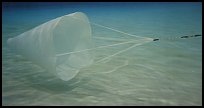 Winslow uses a conical style sea anchor on their unapproved
rafts. This is 24 inches long and made of white coated nylon with an approximately 18-inch diameter front end and a 3-inch diameter open bottom end. Four 1/2 inch webbing shrouds are fitted. A small swivel is fitted at each end of the 50 ft. long parachute cord anchor line.
Winslow uses a conical style sea anchor on their unapproved
rafts. This is 24 inches long and made of white coated nylon with an approximately 18-inch diameter front end and a 3-inch diameter open bottom end. Four 1/2 inch webbing shrouds are fitted. A small swivel is fitted at each end of the 50 ft. long parachute cord anchor line.
 A small, but telling, finishing touch that is evident all around the Winslow rafts, is that all the tied off ends of lines and such are covered by shrink tubing. This not only looks good and neat, it also serves to provide added security to prevent the knots from coming undone. As we've seen many such instances over the years on all sorts of critical equipment, we appreciate this extra effort.
A small, but telling, finishing touch that is evident all around the Winslow rafts, is that all the tied off ends of lines and such are covered by shrink tubing. This not only looks good and neat, it also serves to provide added security to prevent the knots from coming undone. As we've seen many such instances over the years on all sorts of critical equipment, we appreciate this extra effort.
Winslow's drogues are deployed automatically upon raft inflation and attached at the rear of the raft. The anchor line is flaked within a fabric tube to help assist it to play out without tangling. This sea anchor functioned well in tests, though it didn't have quite the effectiveness of Winslow's parachute drogue.
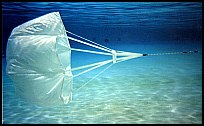 For the approved rafts (optional on all others - $75) Winslow
uses a shaped parachute style sea anchor of white coated nylon. The chute
is 38 inches in diameter at the open end and is attached with six 1/2 inch webbing
shrouds fitted with spreaders to prevent tangling. It is
otherwise the same excellent setup as the unapproved rafts' drogue. It
recovered the quickest of all designs and was very effective. However, doubling the line length, as on Winslow's marine rafts, nearly doubled its performance.
For the approved rafts (optional on all others - $75) Winslow
uses a shaped parachute style sea anchor of white coated nylon. The chute
is 38 inches in diameter at the open end and is attached with six 1/2 inch webbing
shrouds fitted with spreaders to prevent tangling. It is
otherwise the same excellent setup as the unapproved rafts' drogue. It
recovered the quickest of all designs and was very effective. However, doubling the line length, as on Winslow's marine rafts, nearly doubled its performance.
We have a minor concern were with the means of attachment between the line and the anchor. While the shrouds are sewn together, the line is free to slide along the shrouds and doesn't necessarily center itself, which would reduce the effectiveness of the sea anchors. It would be far better to have a loop sewn into the shrouds to capture the line attachment at the correct location.
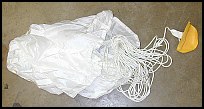 BFG is using the same flat round parachute style sea anchor
made of light parachute (as in jumping out of a plane) material as on previous rafts, 36 inches in diameter (flat) with 8 thin shrouds. The anchor is
deployed upon inflation and is attached to the raft at the end
opposite the main entry on the smaller raft, at one end of the larger ones where those boarding can get tangled in the line. No swivel is fitted to the 29 ft. parachute cord sea anchor line, so failure is only a matter of time. Given the shape of the larger rafts, this is a serious concern. It was moderately effective in our tests.
BFG is using the same flat round parachute style sea anchor
made of light parachute (as in jumping out of a plane) material as on previous rafts, 36 inches in diameter (flat) with 8 thin shrouds. The anchor is
deployed upon inflation and is attached to the raft at the end
opposite the main entry on the smaller raft, at one end of the larger ones where those boarding can get tangled in the line. No swivel is fitted to the 29 ft. parachute cord sea anchor line, so failure is only a matter of time. Given the shape of the larger rafts, this is a serious concern. It was moderately effective in our tests.
The sea anchor attach point failed on the 12-person, literally pulling off the raft. We returned the failed assembly to BFGoodrich and they told us that analysis showed the failure was the result of substandard bonding, an assembly error. This was a chilling discovery when it occurred, it could be disastrous in heavy seas, allowing the long raft to broach and easily capsize given the inadequate ballast.
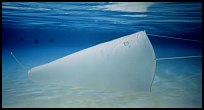 Air Cruisers uses a rather large, huge might be a better word for it, conical sea anchor of lightweight parachute material. It has a 24 inch diameter opening at the entry end and a 3 inch diameter opening with a drawcord to close it off if desired. It is 44 inches long. It is fitted to a much too short 14.5 ft. line of 3/16 inch braided nylon line that doesn't meet the TSO requirement. Effectiveness was significantly hampered by the too short line, yet it was still a top performer. We experimented with longer lines and performance improved a great deal.
Air Cruisers uses a rather large, huge might be a better word for it, conical sea anchor of lightweight parachute material. It has a 24 inch diameter opening at the entry end and a 3 inch diameter opening with a drawcord to close it off if desired. It is 44 inches long. It is fitted to a much too short 14.5 ft. line of 3/16 inch braided nylon line that doesn't meet the TSO requirement. Effectiveness was significantly hampered by the too short line, yet it was still a top performer. We experimented with longer lines and performance improved a great deal.
The valises cum sea anchors were of questionable utility. When they worked, they provided reasonable drag. The one used on the old style BFGoodrich 4-person, being quite large, was very effective when it worked. However, it wasn't hard to tangle in its lines.
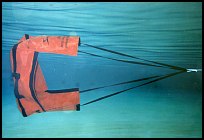 |
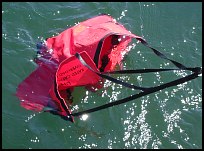 |
The sea anchor is attached to one corner of the raft using 24 ft. of 1/4 inch flat braided nylon line flaked into a cloth tube on the TSO'd rafts, just 16 ft. of line on the non-TSO'd rafts. Despite the flaking, It still tangled on the smaller raft. There are no swivels. The valise cum sea anchor on the single tube rafts does a reasonably good job until its Velcro seams catch on each other under surging conditions, rendering it ineffective. The valise from the larger raft got caught up on its Velcro immediately almost every time we tried it and was nearly impossible to keep functioning as it was very prone to this due to its longer length. Given the minimal weight of a sea anchor, mere ounces, it seems like a lot of trouble to go to with little tangible benefit and lots of detrimental problems and poor performance.
Finally, we have some reservations about the strength of the lines and fittings securing the sea anchors. Marine raft studies found the benefits of a sea anchor were often lost due to the anchor being torn away in moderate to heavy seas, when it is needed the most. While swivels help, they don't address the ultimate strength of the line. Moreover, this strength is reduced because of the knots in the lines. Larger and higher strength line would be a big help.
| Aviation Life Raft Review (click to continue to next page) |
|
| SELECT AND USE OUTDOORS AND SURVIVAL EQUIPMENT, SUPPLIES AND TECHNIQUES AT YOUR OWN RISK. Please review the full WARNING & DISCLAIMER about information on this site. |
Publisher and Editor: Doug Ritter
|
© 1994, 1995, 1996, 2000 Douglas S. Ritter - All rights
reserved. Check our Copyright Information page for additional information. |